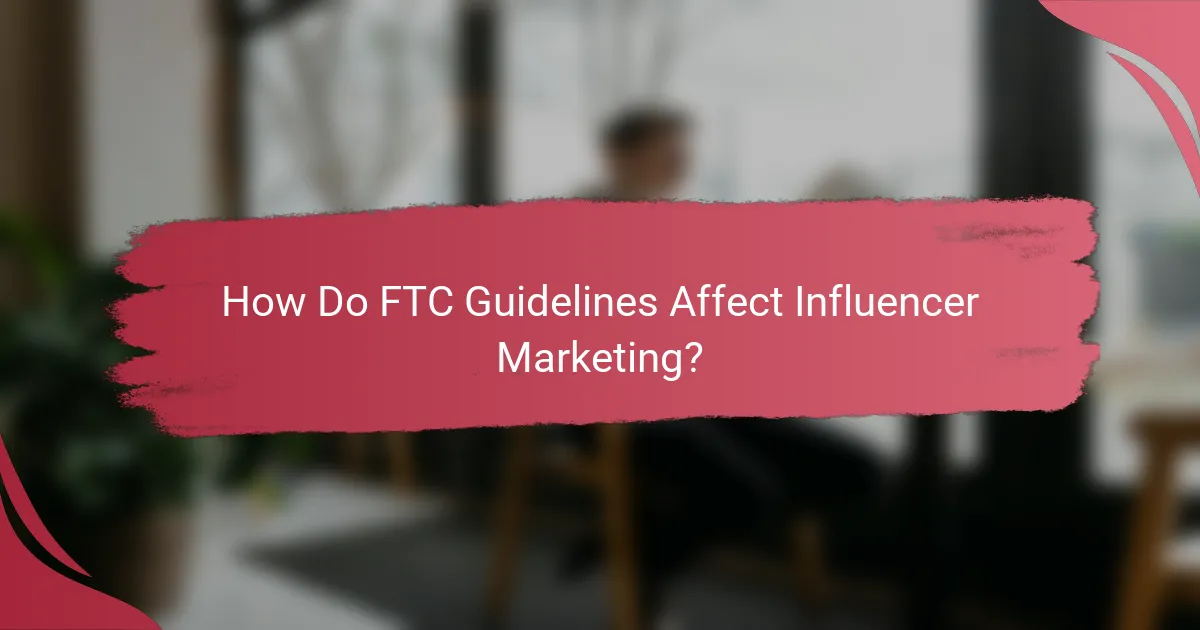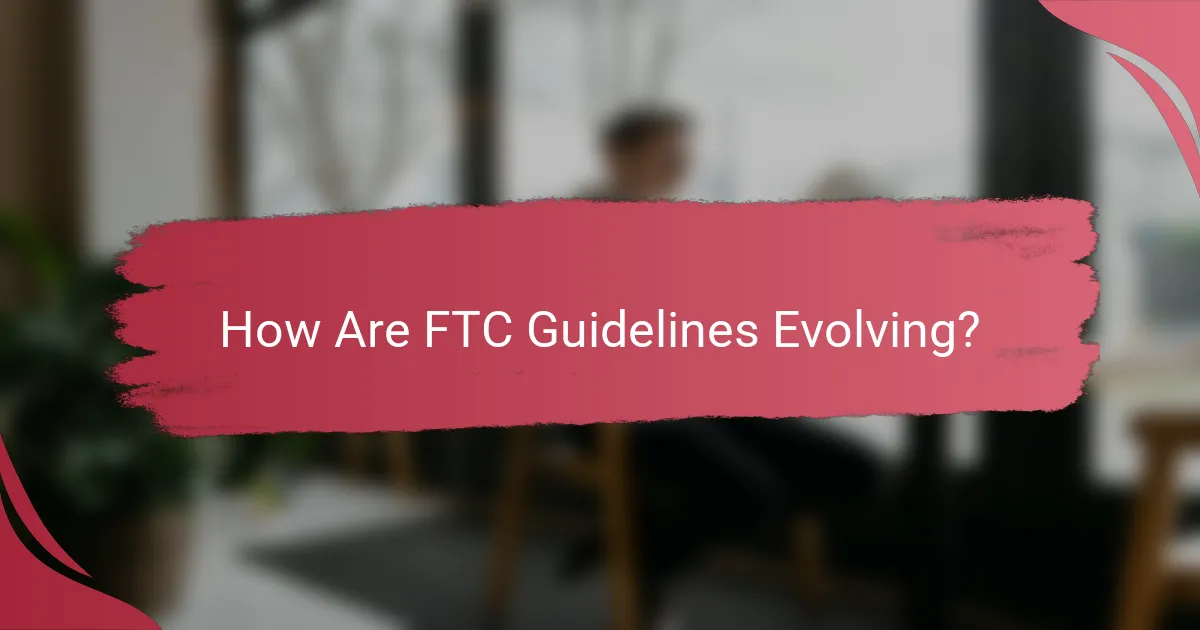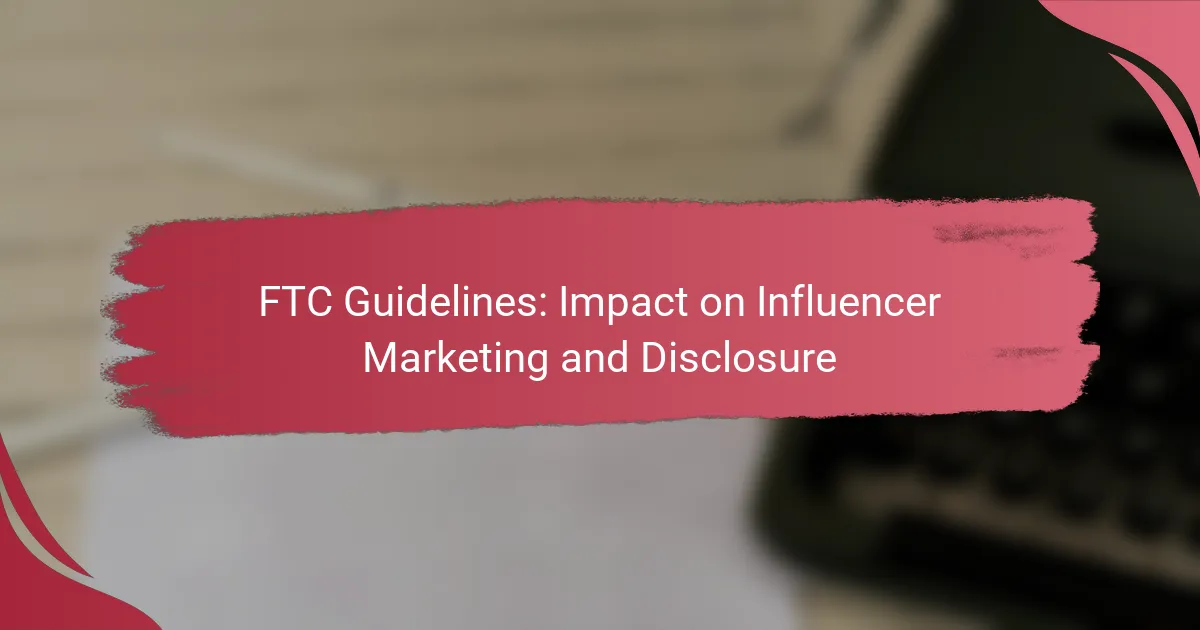The FTC guidelines play a crucial role in shaping influencer marketing by requiring clear disclosures of paid partnerships. This emphasis on transparency helps consumers recognize when content is sponsored, fostering trust in advertising practices. Compliance with these regulations is essential, as failure to do so can result in financial penalties and harm to a brand’s reputation.

How Do FTC Guidelines Affect Influencer Marketing?
The FTC guidelines significantly impact influencer marketing by mandating clear and conspicuous disclosures of paid partnerships. These regulations ensure that consumers are aware when content is sponsored, fostering transparency in advertising practices.
Increased transparency requirements
Under the FTC guidelines, influencers must provide clear disclosures when they promote products or services for compensation. This means that any paid content should be easily identifiable to the audience, typically through hashtags like #ad or #sponsored.
Transparency is not just about using the right hashtags; it also involves placing disclosures in a way that they are noticeable and not buried in lengthy captions. For example, placing a disclosure at the beginning of a post is more effective than at the end.
Stricter disclosure rules
The FTC has set forth stricter rules regarding how disclosures should be made. Influencers are required to disclose their relationships with brands in a way that is understandable to the average consumer. This includes using plain language and ensuring that the disclosure is not misleading.
For instance, simply stating “Thanks to Brand X for the product” may not suffice if the influencer is being compensated. A clearer statement like “I was paid by Brand X to promote this product” provides better clarity and meets FTC standards.
Impact on brand partnerships
The guidelines influence how brands approach partnerships with influencers. Brands must ensure that their influencers are compliant with FTC regulations, which may involve providing training or resources to help them understand disclosure requirements.
Additionally, non-compliance can lead to legal repercussions for both influencers and brands. Therefore, brands are encouraged to establish clear contracts that outline disclosure expectations and provide guidance on best practices for transparency.

What Are the Key Disclosure Requirements?
The key disclosure requirements for influencer marketing focus on transparency, ensuring that audiences understand when content is sponsored. Influencers must clearly indicate any paid partnerships or promotional content to maintain compliance with Federal Trade Commission (FTC) guidelines.
Clear identification of sponsored content
Clear identification of sponsored content is essential for influencers to comply with FTC regulations. This means that any promotional post should be easily recognizable as an advertisement, allowing followers to distinguish between organic content and paid endorsements. For example, using phrases like “Paid partnership” or “Sponsored by” at the beginning of a post can effectively communicate this distinction.
Influencers should also consider the placement of these disclosures. Ideally, they should be placed at the start of the post or video, rather than buried in the comments or at the end, to ensure maximum visibility. This practice not only adheres to guidelines but also fosters trust with the audience.
Use of hashtags like #ad or #sponsored
Using hashtags such as #ad or #sponsored is a straightforward way for influencers to disclose paid content. These hashtags serve as clear indicators that the content is promotional, making it easier for followers to understand the nature of the post. The FTC recommends that these hashtags be placed at the beginning of the post to enhance visibility.
Influencers should avoid vague terms or abbreviations that may confuse audiences. For instance, using #collab or #partner may not convey the same clarity as #ad or #sponsored. Consistency in using these specific hashtags across platforms can help establish a standard that followers recognize and trust.

What Are the Consequences of Non-Compliance?
Non-compliance with FTC guidelines can lead to significant repercussions for influencers and brands alike. These consequences can manifest as financial penalties and lasting damage to a brand’s reputation.
Potential fines and penalties
The FTC can impose fines on influencers and brands that fail to disclose paid partnerships or sponsorships adequately. Penalties can range from thousands to millions of dollars, depending on the severity of the violation and the size of the brand involved.
For example, if a major brand is found to be misleading consumers through undisclosed endorsements, it could face fines in the low six figures. Influencers may also be subject to individual fines, which can vary based on their reach and the nature of the infraction.
Damage to brand reputation
Failing to comply with FTC guidelines can severely harm a brand’s reputation. Consumers increasingly expect transparency, and brands that mislead their audience risk losing trust and loyalty.
Negative publicity from non-compliance can lead to a decline in sales and customer engagement. Brands may also face backlash on social media, where consumers are quick to voice their dissatisfaction, further amplifying reputational damage.

How Can Influencers Ensure Compliance?
Influencers can ensure compliance with FTC guidelines by being transparent about their partnerships and regularly updating their knowledge on advertising regulations. This involves clear disclosures in their content and a proactive approach to understanding legal requirements.
Regular training on FTC guidelines
Regular training on FTC guidelines is essential for influencers to stay informed about the latest regulations affecting their marketing practices. This training can include workshops, online courses, or webinars that cover the nuances of disclosure requirements and advertising standards.
Influencers should aim to participate in training sessions at least once a year, or whenever significant updates to the guidelines occur. Keeping abreast of these changes helps avoid potential legal issues and builds trust with their audience.
Consulting legal experts
Consulting legal experts is a critical step for influencers seeking to navigate the complexities of FTC compliance. Legal professionals can provide tailored advice based on an influencer’s specific situation, including the types of products they promote and their audience demographics.
Influencers should consider establishing a relationship with a legal expert who specializes in advertising law. This can be particularly beneficial when launching new campaigns or entering into partnerships, ensuring that all promotional content meets regulatory standards.

What Tools Help Manage Influencer Compliance?
To effectively manage influencer compliance, brands can utilize various tools designed to streamline the process of monitoring and ensuring adherence to FTC guidelines. These tools help track disclosures, manage contracts, and maintain transparency in influencer marketing campaigns.
Influencer marketing platforms
Influencer marketing platforms serve as centralized hubs where brands can connect with influencers, manage campaigns, and monitor compliance. These platforms often include features for tracking posts and ensuring that influencers use proper disclosures, such as hashtags like #ad or #sponsored.
When selecting an influencer marketing platform, consider factors like user interface, available analytics, and the size of the influencer network. Popular platforms include AspireIQ, Upfluence, and Influencity, each offering unique features tailored to different marketing needs.
Compliance tracking software
Compliance tracking software specifically focuses on monitoring influencer activities to ensure they meet legal and ethical standards. This software often automates the process of checking for proper disclosures and can generate reports for brands to review.
When choosing compliance tracking software, look for tools that integrate with your existing marketing systems and provide real-time alerts for any compliance issues. Examples include tools like Hootsuite and Sprout Social, which offer features for tracking influencer content across multiple social media platforms.

What Are the Best Practices for Brands?
Brands should establish clear expectations and maintain oversight when working with influencers to ensure compliance with FTC guidelines. This includes defining disclosure requirements and regularly reviewing influencer content for adherence to these standards.
Establish clear guidelines for influencers
Brands must provide influencers with specific instructions on how to disclose sponsored content. This includes using clear language such as “ad” or “sponsored” at the beginning of posts, ensuring that the disclosure is easily visible and understandable to the audience.
Consider creating a guideline document that outlines the do’s and don’ts for influencers. This can include examples of acceptable disclosures and a list of prohibited practices, such as misleading claims or inadequate disclosures.
Monitor influencer content regularly
Regular monitoring of influencer content is crucial to ensure compliance with FTC guidelines. Brands should set up a schedule to review posts and stories, checking for proper disclosures and adherence to brand messaging.
Utilize tools that track influencer activity across social media platforms. This can help identify any potential issues early on, allowing brands to address them promptly and maintain a positive reputation.

How Are FTC Guidelines Evolving?
The Federal Trade Commission (FTC) guidelines are increasingly adapting to the rapid growth of influencer marketing. These changes emphasize transparency and the necessity for clear disclosures to protect consumers from misleading advertising practices.
Increased focus on social media platforms
The FTC is placing greater emphasis on social media platforms as primary channels for influencer marketing. Influencers must clearly disclose any paid partnerships or sponsorships in their posts, ensuring that followers understand when content is promotional. This includes using hashtags like #ad or #sponsored in a prominent manner.
Brands and influencers should regularly review platform-specific guidelines, as each social media site may have unique requirements for disclosures. For example, Instagram and TikTok have specific recommendations on how to format disclosures to enhance visibility and comprehension.
Emerging trends in consumer protection
Consumer protection trends are shifting towards stricter enforcement of advertising standards. The FTC is actively monitoring influencer marketing practices to ensure compliance with disclosure requirements. This includes potential penalties for influencers and brands that fail to adhere to these guidelines.
To stay compliant, brands should implement training programs for influencers they partner with, emphasizing the importance of transparency. Regular audits of marketing campaigns can help identify and rectify any disclosure issues before they lead to regulatory scrutiny.

What Future Trends Should Brands Watch?
Brands should closely monitor evolving FTC guidelines as they significantly shape influencer marketing strategies. Key trends include increased scrutiny on transparency, the rise of micro-influencers, and the integration of new platforms that challenge traditional advertising norms.
Increased Scrutiny on Transparency
As the FTC continues to emphasize the importance of clear disclosures, brands must ensure that influencers are transparent about their partnerships. This means using clear language and appropriate hashtags like #ad or #sponsored in posts. Failure to comply can lead to penalties and damage to brand reputation.
Brands should regularly review their influencer agreements to ensure that disclosure requirements are explicitly stated. Providing influencers with guidelines on how to disclose their relationships can help maintain compliance and build trust with audiences.
Rise of Micro-Influencers
Micro-influencers, who typically have smaller but highly engaged followings, are becoming increasingly popular among brands. They often yield higher engagement rates and can be more cost-effective than larger influencers. Brands should consider partnering with these influencers to reach niche markets effectively.
When selecting micro-influencers, brands should evaluate their audience demographics and engagement metrics to ensure alignment with their target market. This approach can enhance authenticity and foster stronger connections with consumers.
Integration of New Platforms
Emerging social media platforms are changing the landscape of influencer marketing. Brands should stay informed about new channels like TikTok or emerging apps that attract younger audiences. These platforms often have unique features that can enhance creative marketing strategies.
To leverage these platforms effectively, brands should experiment with different content formats and engagement tactics. Collaborating with influencers who are already successful on these platforms can provide valuable insights and boost brand visibility.



